Take a walk on the wild side with NCC
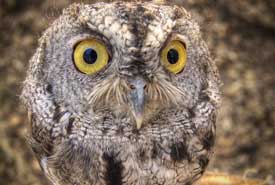
Western screech owl (Photo by Josh Shaw)
The field observations made by scientists at the Nature Conservancy of Canada (NCC) are key to telling the stories of conservation. On an average day field staff may encounter an array of wildlife species. Their ordinary field day can yield extraordinary stories about the species on our properties.
World Wildlife Day is held on March 3rd each year and celebrates our planet’s wonderful and diverse species. In honour of this day, here are two stories by NCC staff about some pretty memorable experiences with wild species:
The following is an excerpt of “Night sounds,” from the BC Region's Stories from the Field:
In British Columbia, scientists are working hard to protect owl species by conducting nighttime surveys. As NCC intern Jon Kelly knows, a search isn’t always about finding what you’re looking for:
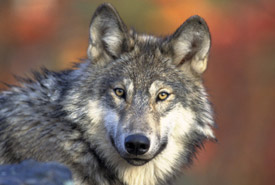
Grey wolf (Photo by Gary Kramer, courtesy of USFWS)
“Mike and I travelled halfway across the province to the Tatlayoko Valley, a remote and sparsely settled valley about three hours west of Williams Lake. NCC operates the Tatlayoko Lake Bird Observatory (TLBO) each August and September in an effort to track the migratory birds passing through the valley on their long journeys south.
“We were in the valley to assist with various stewardship activities, and after TLBO assistant bander Chris Chutter heard about our attempts to find western screech owls in the Elk Valley he invited Mike and I to have a second go at finding owls in the night.
“Suddenly, an eerie howling filled the silence. A wolf was calling, and from not so far away. Other wolves began howling in return, calling back and forth for many long minutes, shattering any sense of the forest being a benign place for a midnight stroll.
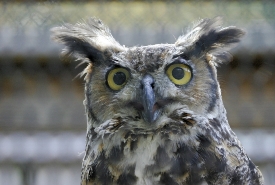
Great horned owl (Photo by Bill Hubick)
“By the time Chris returned to get us, the hair was standing up on the back of our necks. While we felt lucky to have heard the wolves' haunting calls, we stepped into the scrubby forest with no small amount of trepidation in our hearts.
“Chris was determined to find us an owl. Using only his own voice Chris vocalized the call of the great-horned owl, which is known to be in the area. Almost immediately we heard a call come back. Chris called again, and again a juvenile owl replied. Back and forth human and owl called until finally the owl lost interest and we were treated to night silence again.
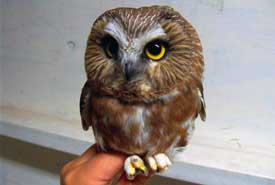
Northern saw-whet owl at TLBO (Photo by NCC)
“While it was exciting to hear the calls of a nearby great-horned owl, we hadn't lost sight of our main goal: to catch and band the northern saw-whet. With that, we went on a few more net runs in the hope that one might turn up. But our search for the northern saw-whet owls left us empty-handed.
“Those sounds are the soundtrack to my amazing summer as an intern with NCC. I came away from these surveys with a reinforced appreciation of the wonderful — and sometimes unexpected — experiences to be had in the natural places NCC works to protect.”
As in Jon’s story, sometimes you find a species, and sometimes a species finds you. Conservation often allows these incredible close encounters with wildlife to occur.
The following is an excerpt from "A 'beary' scary encounter on the Wreck Bay Nature Reserve," by Kristyn Ferguson.
In Ontario, NCC scientists Laura Robson and Kristyn Ferguson were out on the Wreck Bay Nature Reserve when they ran into a stranger in the forest:
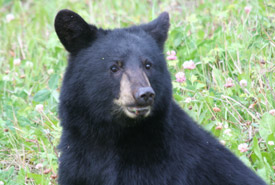
Black bear (Photo by NCC)
“On a cold, cloudy, windy afternoon we travelled by boat to this water access only property to search for reptiles, frogs, birds, spring plants and really anything we could find.
“As we listened for frogs, flipped logs for salamanders and kept our eyes peeled for new and interesting plant species, I noticed Laura and I were being much quieter than we usually were and luckily were standing right next to each other when I scanned around…and locked eyes with a black bear. He was on all fours, on the skinnier side, but as tall as my hip. I can still hear my own voice, quietly, masking so much fear: 'Laura, there's a bear.'
“We shared a look of utter terror, and then I said softly, 'Get the bear spray out of my bag.' Once I had it in hand with the safety off, our training on how to handle bear encounters kicked in and we started being BIG and LOUD to frighten the bear away.
“Laura reminded me not to run (wow, what a powerful urge it was to run!) and we walked swiftly away. We paused for a moment to look around, I spotted the bear again — he was coming at us from a different direction, and not slowly either. We re-engaged in our mission to scare it away.
“You could hear the anger and then the disappointment in our raised voices as we realized this bear was not pausing in his pursuit towards us. At that point we didn't see another option except a hasty retreat back to the shoreline.
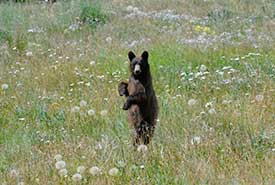
Black bear (Photo by Brendan Matthews)
“We got there and stood on the rocky terrain, basically vibrating we were shaking so hard, staring back into the forest where we'd left the bear. Luckily our water taxi soon arrived and sped us back safely to the mainland.
"In retrospect, I'm proud of us for engaging our bear safety training. I’m very glad I didn't have to use my bear spray or end up actually face to face with the bear in some sort of altercation. I am grateful, but it took many days before the flashbacks went away and I felt normal again. Often I’d hear in my head as I went to drift off to sleep at night my own voice, saying: 'Laura, there's a bear.'"
Kristyn's story is a good reminder to keep an eye out for species and be aware that wildlife are exactly that: wild life.
World Wildlife Day allows us to celebrate not only Canadian species and those around the world, but the habitat they rely on to survive and thrive; which is protected thanks to conservation efforts by organizations such as the Nature Conservancy of Canada. So this World Wildlife Day, let’s celebrate our planet’s diverse species.
Do you have any wild stories of your own? Share your story with us in the comment box below.


